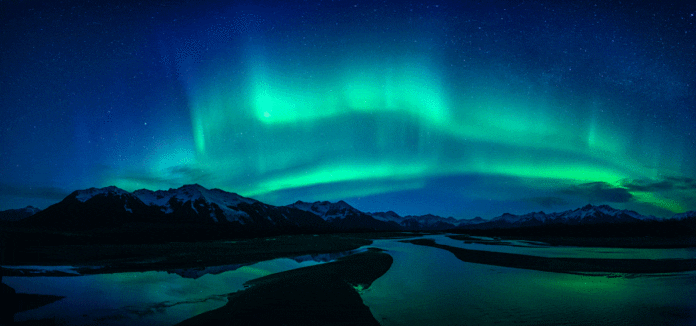
I’ve been asked many times the best way to find/see the Northern Lights, or Aurora Borealis, in the Cordova area. Many factors go into that equation, but here’s what works for me. While the aurora is still not fully understood, a number of basics are known. Understanding these will increase your chances of seeing those amazing lights that frequent the area we live in.
The aurora is generated by a combination of the sun’s activity, earth’s magnetic field, ionosphere, atmosphere and other entities as well. Projected solar winds and particles are funneled into specific areas by earth’s magnetic fields high in the heavens, colliding with molecules of oxygen, nitrogen and other atmospheric elements. This combination glows akin to a fluorescent light tube, and occurs year around, during the summer as well as the winter. In the summer though, almost 24 hours of sunlight prevents the aurora’s glow from being seen.
To get an idea whether the aurora is likely, I first go to the website Spaceweather.com. There are other sites, but the essential information is quickly and cleanly gathered from Spaceweather. The three factors I look at are the solar windspeed, proton density, and the interplanetary magnetic field. Windspeed is the speed of particles encountering the earth’s magnetic field that have been thrown off by the sun into space, and the average – quiet – measurement is around 320 km/s. Secondly, there’s the proton density, which on an average, quiet, non-auroral night will be around the 3.5 protons/s mark. The third factor is the interplanetary magnetic field, or Bz, which will vary widely and quickly throughout the night between north and south, and the numbers are usually vary between 1 and 7 either way. The effect of the Bz can be likened to a water faucet, turning the water (aurora) on (south) and off (north) in an instant. The Bz indicates whether the earth’s magnetic field is attracting or repelling the solar wind, with the north repelling and the south attracting. Having said that, I’ve read articles insisting the aurora is not visible during a northern Bz but have personally seen brilliant auroras with a 4 or 5 northern Bz. Nevertheless, generally speaking, a southern pointing Bz will be much more favorable to seeing a lively aurora. My experience leads me to suspect that had the northern Bz auroras I’d seen had a southern Bz instead, they would have been much more intense.
If all this seems a little complicated, go to the Spaceweather website.
Look at the top left hand side, along the sidebar that runs the length of the page. From the top left, you will see the solar windspeed listed. Then directly below that, you will see the proton density. Continuing further down, you will see the earth with the auroral oval in green and then below that you will see the Interplanetary Magnetic Field. Two figures are given, but the Bz is the one you want. Remember the numbers mentioned, and you will have an idea whether the aurora is visible or not. If the windspeed is 350 or so, ho hum … If it’s 500 or 600, something is going on somewhere. And if it’s 700+, time to get yourself to a dark sky!!! Similarly, if the proton density is 3.5, that’s no particular indication of activity. If it’s 7 or 10 or 15 or even 19 (the highest I’ve personally seen is 19), auroral activity is high somewhere. If all this is going on and the Bz is north, there may or may not be a fabulous aurora out there. But if the Bz is southward by any degree, there should be some good auroral activity.
There are more considerations and nuances that I will follow up on in part two of this article, but for now, get these 3 items clear and you will be on your way to being a successful aurora hunter!
Having said all of that, when it comes to seeking out the aurora borealis in northern skies, nature will have its own way. You’ll never know if you never go … There is no substitute for getting out there with eyes on the sky; serendipity is a beautiful thing














